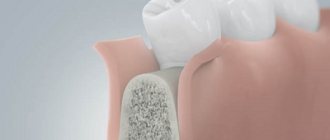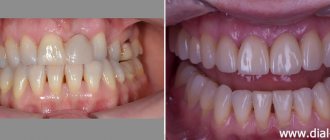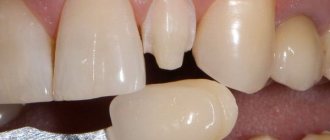Anyone can lose a tooth for a variety of reasons, be it dental disease or injury. At first glance, the problem seems harmless and not everyone is in a hurry to eliminate the defect as soon as possible. In fact, prolonged absence of teeth can lead to serious consequences for the body, increasing the cost of treatment and its duration. Therefore, experts do not advise delaying, but recommend inserting new teeth as early as possible. There are many reasons in favor of this, which we will consider below.
Implantation methods after tooth extraction
Dental implantation after extraction is carried out according to two protocols:
- One-stage - involves installing an implant immediately into the socket of the extracted tooth. There are techniques that allow not only the installation of an implant, but also the fixation of a crown on it.
- Delayed - requires complete healing of the hole and restoration of bone tissue after removal. The bone is restored in 2-5 months depending on the health of the patient. Only then is implantation carried out.
How to solve the problem
The dentist who inserts the teeth can recommend several methods for correcting the defect. The most effective of them is dental implantation. At the first stage, an implant is placed in the jaw, then a metal-ceramic crown is fixed onto it. Teeth can be inserted in this way for patients who have both single and multiple defects. Implants are also installed in completely edentulous patients. Unlike conventional removable prosthetics, this method is more reliable and functional. For those who are interested in how to insert teeth without implantation, dentists can recommend other methods:
- Crowns. They are installed on a previously ground tooth, if most of it is preserved.
- Bridge. Consists of single crowns that are soldered together. The denture is installed on the ground adjacent teeth.
- Removable dentures. Does not require turning. They are fixed in the oral cavity using hooks and other mechanisms.
- Pin. It is a rod made of metal or fiberglass that is installed in the preserved root. The prosthesis is subsequently fixed onto it.
- Implant. Helps replace lost roots. This restoration method is the most effective, you can see this in the before and after photos.
In order to find out which teeth are best to insert, you need to schedule a free consultation with a dentist. The specialist will examine the oral cavity, and, if necessary, prescribe an examination and select the most optimal method of restoration.
When it is possible to perform implantation - the doctor chooses after a complete diagnosis
It is necessary to study the condition of the bone tissue, its size and density. Based on the results, the doctor makes a decision - delayed or immediate implantation. Our Center is equipped with diagnostic equipment, so results can be obtained within 15 minutes . But this is only a preliminary assessment; the final decision is made after tooth extraction.
Levin Dmitry Valerievich
Chief physician, Ph.D.
Indications and contraindications for immediate implant placement
Indications
- Mechanical damage to the root - fracture, dislocation
- Restoration of frontal units
- Therapeutic treatment did not bring results
- Sufficient bone volume
- No contraindications
Contraindications
- Deficiency, looseness of bone
- Inflammation at the root apex
- Enlarged socket after removal
- Inflammatory processes of the oral cavity, gum pathologies
- Reduced immunity, systemic diseases
- Pregnancy, breastfeeding period
How to do dental implantation immediately after extraction
After a tooth is removed and an implant is immediately placed, the process of osseointegration occurs faster. The hole with the artificial root begins to heal, the blood clot turns into bone tissue that surrounds the implant in the early stages of healing. This promotes accelerated osseointegration of the implant with the jawbone, ensuring reliable fixation and stability.
Stages:
Diagnostics
Full diagnostics, choice of design in the absence of contraindications.
Tooth extraction, artificial root installation
Local anesthesia or sedation is used. A bed is formed in the hole, an implant is installed, and the space around is filled with osteoplastic material. After the procedure is completed, the gums are sutured. A temporary removable prosthesis is installed. Engraftment lasts 4-6 months.
Prosthetics
After osseointegration of the implant with the jaw bone, the gum is opened, and a gum former is fixed to the implant for 10-14 days to create a gum contour. Then the former is replaced with an abutment, and a crown made from the impression is installed.
In rare cases, it is possible to fix the crown to the implant immediately after its installation. At the same time, the crown is removed from the bite so that the implant does not move during chewing. This method is recommended for the anterior parts of the jaw in order to quickly restore the defect. Not suitable for lateral use due to active chewing loads.
Difficulties you may encounter
Among the most common reasons for refusing to visit the dentist and timely restoration of missing teeth are the following:
- Fear of pain. A large number of people avoid the dentist for this reason. They do not even suspect that modern methods of pain relief are very effective and allow them to avoid any unpleasant sensations. If you are asking the question “does it hurt to insert teeth?”, then the experts answer you – “no!”
- Some refuse to restore the defect due to the length of the procedure itself. Indeed, classic two-stage implantation involves the implant engraftment stage for 6 months. In fact, this is not such a long period, only six months. There are also faster methods, for example, the dentist may suggest immediately inserting the tooth in place of the removed one.
- A lack of money. How to insert teeth if there is no money? The financial part of the issue is quite important. The dentist can offer various methods of restoring teeth, from cheap to very expensive. Therefore, the patient can choose the best option based on his budget. Today there are a large number of clinics where you can get teeth inserted in installments or on credit. Overall, recovery can be very accessible for all people. When looking for a clinic where you can get teeth inserted cheaply, you must avoid those institutions that operate illegally and have specialists with a dubious reputation on their staff.
The dentist must take an individual approach to the patient who needs to have teeth inserted. Options must be selected so that they take into account the wishes of the person and his financial capabilities. One patient may need to insert a front tooth in one day, while another may need to restore multiple defects using modern and aesthetic materials. With a competent and professional approach, you can eliminate any problems without pain and fear.
Advantages and disadvantages of one-stage dental implantation
pros
- One operation is performed, waiting time is reduced
- Simplified installation process
- Minimal loss of mucous and bone tissue after surgery
- If the technology is followed, the percentage of successful operations is 99.6%
Minuses
- Contraindicated in chronic inflammation, diseases
- Not performed if there is insufficient bone
- Strict rehabilitation period, frequent visits to the implantologist
For a favorable outcome, entrust the operation to a surgeon with extensive experience in this protocol.
Is it possible to place an implant if a tooth has been lost for a long time?
Whether it is possible to place an implant if the tooth was removed a long time ago is decided only by the surgeon after a complete diagnosis. Already 3 months after removal, the bone is so absorbed that it may not be enough to install an implant and augmentation will be required. The recommended implantation period is no later than 2-3 months.
In case of bone atrophy, osteoplasty is performed:
- Guided bone regeneration . Most often performed on the lower jaw, bone materials, biomembranes, and bone growth stimulators are used. It is used if the width and height of the patient’s bone is not enough for implantation. If bone tissue atrophy is insignificant, it is possible to perform NCR simultaneously with the installation of implants. Otherwise, it is carried out in a separate preliminary stage. It takes 3-4 months for the grafted material to fuse with the bone.
- Sinus lift. Intervention in the bone structure of the upper jaw in the area of the maxillary sinuses. Using instruments, tissue is punctured to raise the bottom of the sinus. The resulting space is filled with osteoplastic material. The operation can be closed or open. A closed sinus lift is performed for minor bone atrophy simultaneously with the installation of implants. Open - for moderate and critical atrophy in a separate stage.
When to insert an implant immediately after extraction
- If there is inflammation;
- fistula, granuloma, cyst;
- against the background of diseases of the mucous membrane;
- with insufficient bone volume or pathological changes;
- if the removal was performed carelessly (severely injured hole) and more.
Contraindications also include systemic diseases :
- diabetes;
- pathologies of the endocrine system;
- oncology;
- mental disorders, depression;
- allergy to anesthetics;
- weakened immunity due to viral and bacterial infections;
- tuberculosis;
- HIV, syphilis;
- hemophilia and other blood diseases;
- chronic diseases at the acute stage, etc.
Sometimes situations arise when one-stage implantation is not completed. In this case, the operation is completed after extraction. The implant installation procedure is postponed for some time to allow the wound to heal. Next, treatment is performed according to the classical protocol.
Price
The Center for Private Dentistry Dr. Levin provides a case payment system.
- When implanting Nobel Biocare PMC Select or Groovy, the cost includes the surgical stages, including the design model, surgery, anesthesia, and all necessary procedures. The price is indicated taking into account the preparatory stage.
- Removal is paid separately, the price includes surgery, inflammation relief, socket rehabilitation, consumables, anesthesia.
- The case for installing a metal-free zirconium dioxide crown includes all stages - impressions, manufacturing, installation.
- Sinus lifting and any bone tissue augmentation operations are paid separately.
Causes of dental injuries
Most often, dental damage occurs at one moment, for example, during an accident, a fall, a strong blow to the jaw, or performing a sports exercise. Sometimes a tooth shifts gradually if a future dental patient periodically chews hard objects, nails, or tears threads with his teeth. As a result of such manipulations, tooth enamel is gradually worn away and chips appear. Subsequently, the tooth may crumble during ordinary activities, such as brushing or chewing food.
In good dentistry, treatment procedures are always successful, in compliance with all rules. However, if you decide to take a risk and save money, the tooth may be destroyed if the operation is unsuccessful. For example, dislocation can occur due to inaccurate removal of nearby teeth. Injuries are also common when installing orthodontic appliances.
Alternative options for tooth restoration after extraction
After removal, doctors recommend restoring the tooth in a short time. This is caused by bone tissue atrophy, which begins in the absence of chewing load, which complicates recovery in the future.
If for some reason the patient is not ready for implantation, alternatives can be offered:
- Bridge prosthesis. It is a non-removable structure of interconnected crowns. For installation, two supporting teeth are depulped (nerve removal, canal filling) and ground down for crowns. At the same time, the load on the support increases, mobility develops, which is why the bridge will need to be replaced. The bridge structure is not able to completely prevent bone tissue atrophy, but it prevents rarefaction, displacement, and curvature of the dentition. The rate of bone atrophy and the development of mobility depend on the patient’s health.
- Removable dentures . They represent a structure made of artificial gum with soldered crowns, attached to adjacent teeth with hooks. The supporting teeth are ground down if the fastenings are metal. The prosthesis has a range of mobility and requires careful care, since food particles can get under it. Removable dentures do not stop atrophy, but they do prevent displacement of adjacent units.
Implantation prevents all problems, including bone atrophy. An implant is an artificial root on which a crown is placed. Neighboring teeth are not ground down or damaged. The chewing load is maintained. The survival rate of dental implants is 98%. Implantation is considered the most reliable way to prevent bone resorption.
Reason 2 – increased load on neighboring teeth
If a person refuses to insert teeth in a timely manner, the load on the dentition will be distributed unevenly. As a result, the abrasion of the enamel will increase, and the risk of developing caries will increase significantly. In such patients, teeth will decay very quickly and in just a few years you can be left with completely toothless jaws. Next, a logical question arises: “how to insert teeth if there are no teeth at all?” Such methods exist, but they are very expensive (All-on-4 all-on-4 implants) or not effective enough (removable dentures).











